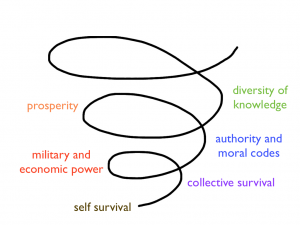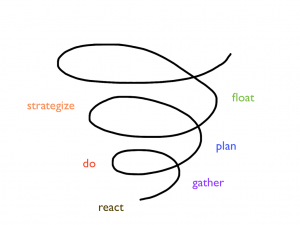What is the role of planning and planners if the overriding purpose of a city is to integrate the needs of its people, with its context, to create a habitat in which people survive and thrive? Simply, ‘planning’ a city is an activity that supports our collective work to organize ourselves into, and in, cities with the objective of ensuring that our habitat serves us well.
Modes of organizing

In Is an unplanned city unplanned? Part 3 , I introduced a spiral of evolving city purposes (Figure 1). With each level of purpose of the city, there is a corresponding mode of organizing.
500 years ago, when St. John’s harbor was settled (see Part 1 and Part 2), choices were made to ensure people’s individual survival and that of the settlement. They took advantage of a geographic location in proximity to Europe and a calm harbour that didn’t freeze, two geographic factors that contribute to the harbour’s role in transatlantic shipping today. Specific to the settlement itself, they ensured a supply of fresh water and materials to build shelter. Decisions were made in response to context to ensure survival, and once immediate survival needs were met, they began organizing themselves.

Four levels of organizing (Figure 2) are evident in early St. Johns: reacting (survival), gathering (collective survival), doing (power and might), and planning (authority and moral codes). In the early days of St. John’s people did what needed to be done. Activities were coordinated – the port authority, the court house, government house, custom house. Resources were coordinated – water supply, roads. Likely in ‘do’ mode, decisions were made by the governor about where to locate the church, the various government buildings. In ‘do’ mode, forts were constructed. In ‘do’ mode, the homes and fishery in support of the fort were constructed. As authority was needed, it arrived.
Once our survival needs are met, we are able to expand our view and consider others. We gather with others to make meaning of what has happened and what will happen. We work together to survive and begin the journey to thrive – in the pub or church. When things need to be done, we meet to sort out what to do. Some individuals will just do what needs to be done and set up fish flakes wherever it works. Build a dock where it works. This can feel unruly, and when sufficiently so, someone will try to give structure to things – in the case of St. John’s we the Port Authority, government house, custom house, the court house.
In St. John’s, the ‘doing’ also takes place at the scale of nations: the British, French, Spanish and Portuguese all want to claim the fishery and access to the fishery. In ‘doing’ mode, they build kingdoms and lay claim to territory. As time goes on, hints of plans take root in St. John’s. And plans come with authority to make sure that the plan is implemented. St. John’s’ early maps reveal how this took place: pipes for water supply, the custom house (and its rules), road construction, property ownership, and who occupies premises. In response to our life conditions we organize as appropriate (Figure 2).
A sixth purpose for cities
The fifth purpose for cities is to generate prosperity for its citizens, in thriving economies, a mitigation of the rules that emerged from authorities, and a renewed sense of entrepreneurial spirit and creativity. In St. John’s this id evident in the corporate structure for the St. John’s Port Authority: users of the port, City of St. John’s, the Government of Newfoundland and Labrador and the Government of Canada. This is partnership, not a central authority simply consulting with stakeholders. And while not a ‘city’ organization, it certainly shapes St. John’s.
A sixth purpose is emerging for today’s cities (Figure 1): to create the conditions for people to fully access our diversity of knowledge. We are growing into an understanding that city hall is not the only player who organizes a city but that there are many others involved: chambers of comer, community foundations, advocacy groups, developers and builders, citizens, health authorities, school systems, provincial and federal government, citizens, etc. All and each of these players shape our increasingly complex cities. They are increasingly demanding a role in the process of creating our cities.
The planning profession – new work
The formal act of planning our cities emerged as new work when we required additional order in response to life conditions of a certain time, geography, challenges and social circumstances. Planning in Canada is a fairly recent phenomenon: The Town Planning Institute of Canada was established in 1919, later turning into the Canadian Institute of Planners in 1974. Further evolution of the profession has involved the regulation of the profession by provincial governments in recent decades: Alberta, New Brunswick, Nova Scotia, Ontario, Quebec and Saskatchewan.
Today, we see the formal act of planning land uses in municipal legislation: zoning by-laws, area structure plans, municipal development plans and official community plans. In their work, planners help us organize our social and community services, build economic capacity, address transportation and infrastructure needs, manage cultural and heritage resources, ensure environmental protection. The Canadian Institute of Planners defines planning as:
the scientific, aesthetic, and orderly disposition of land, resources, facilities and services with a view to securing the physical, economic and social efficiency, health and well-being of urban and rural communities.While this definition is complicated, it is clear that the planning profession is in place to help the city be the best it can be for its residents.
Two roles for planning today
The challenge for citizens and planners today is to recognize two different kinds of planning support to cities:
- Provide the answers – traditional, linear, planning expertise.
- Create a habitat for exploration – support the city’s awareness so it can respond purposefully, appropriately.
The difference between the two is simple: planners have expert knowledge vs. citizens have expert knowledge. There are times when the specific expertise of planners is needed. This is “top-down” activity, which is the right thing under certain circumstances. The second role, however, requires acknowledgement that a city is trying to organize itself and there is work to be done to help the city see itself (more on this, what Marilyn Hamilton calls integral vital signs monitoring, in later posts). To get what we need from our cities, we each need to be in tune to what our cities need of us. This means honing our telling and listening skills in our work in the world. We need to notice not what we want to do, but what is being asked of us. This is where the next evolutionary step will emerge for the profession – a profession in service to cities and their inhabitants.
Planners are relevant when supporting the work of a whole city to organize itself. Individually and collectively, planners support our work to improve our habitat. Planners are well positioned to create the conditions for cities to see changing life conditions and for cities to figure out how to adjust. Our work, then, is to create the conditions for ourselves, and our cities, to see and respond to life conditions. Some of this work takes the form of planning as we know it, and some will take other forms. The purpose of planning is to support city efforts to notice, adjust and organize to ensure people survive and thrive.
To answer the question, ‘Is the unplanned city unplanned?’, I note that all cities are organized to meet a purpose in a given context. ‘Planning’ is only one mode of organizing. The unplanned city is unplanned, but not created without purpose. This is significant. Planned cities don’t achieve their plans exactly anyway. The real matter at hand is knowing the purpose(s) of cities. Whether planned or unplanned, all cities are organized.
My next post will explore the voices that make a whole, integral city.
Sources –
Beck, Don Edward and Cowan, Christopher C., Spiral Dynamics: Mastering Values, Leadership, and Change, Blackwell Publishing Ltd., Oxford (2006), particularly pages 52-56.
Hamilton, Marilyn, Integral City: Evolutionary Intelligences for the Human Hive, New Society Publishers Inc., Gabriola Island (2008)
Sanders, Beth, “From the High Water Mark to the Back of the Fish Flakes: The Evolutionary Purpose of Cities,” Vol 51, No. 4, p 26-31, Plan Canada. Print publication of the Canadian Institute of Planners.